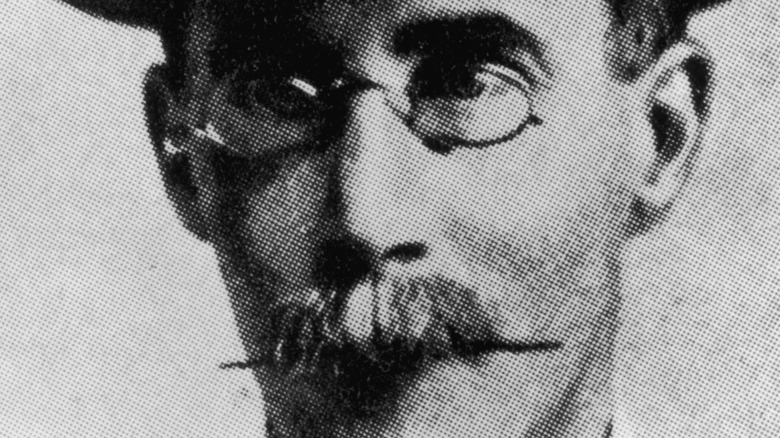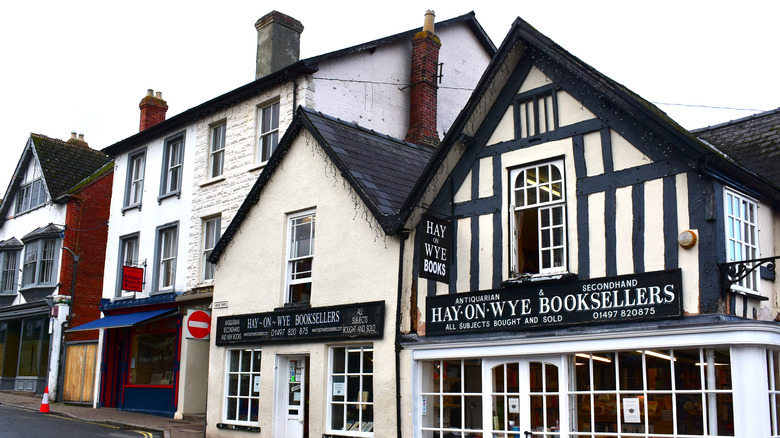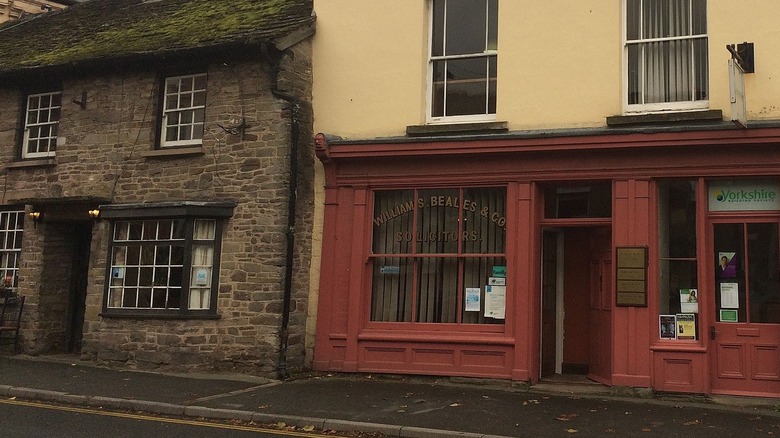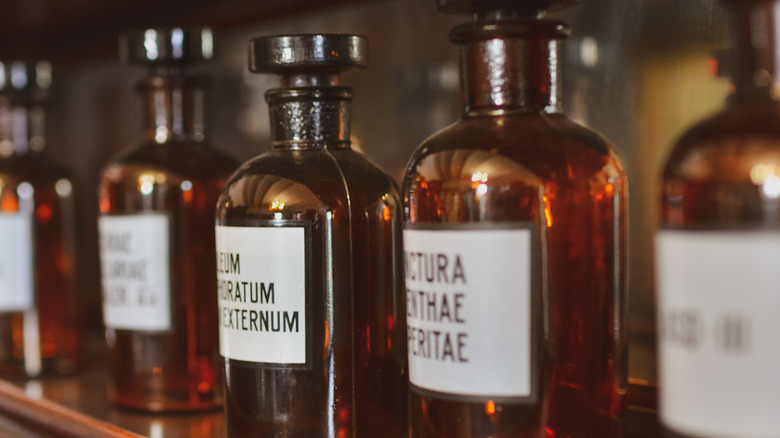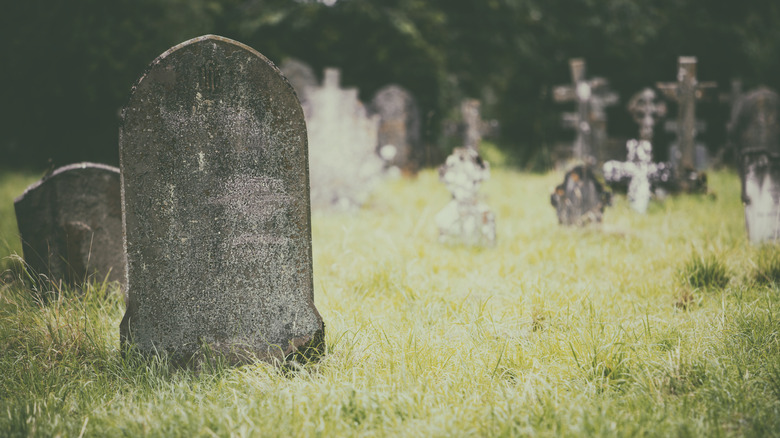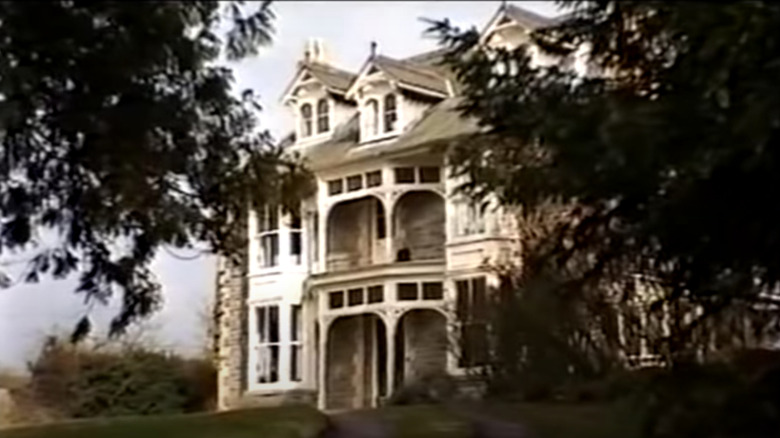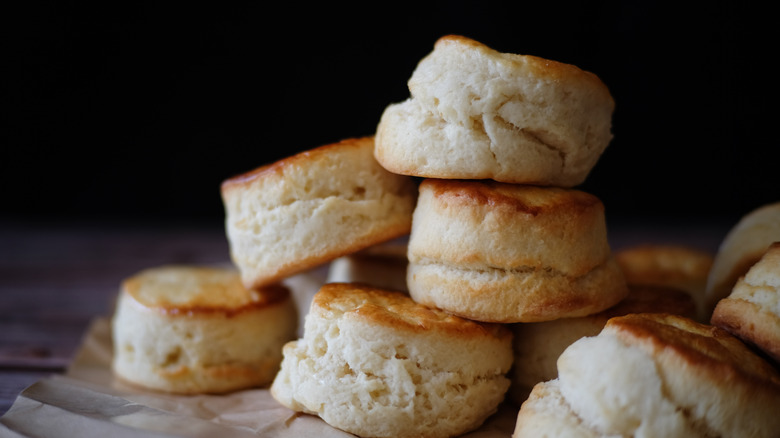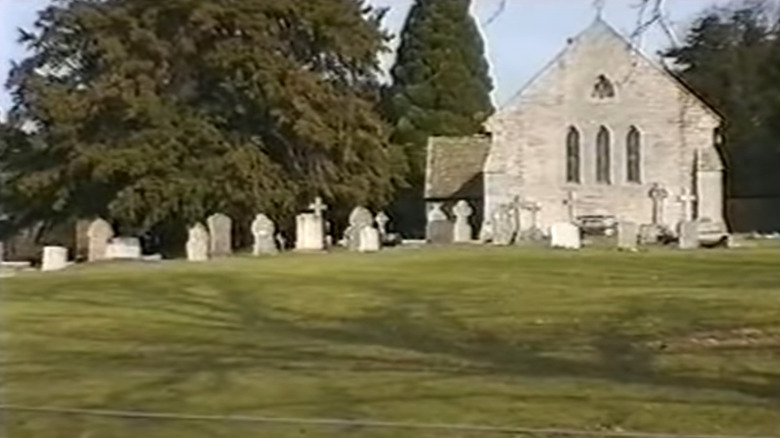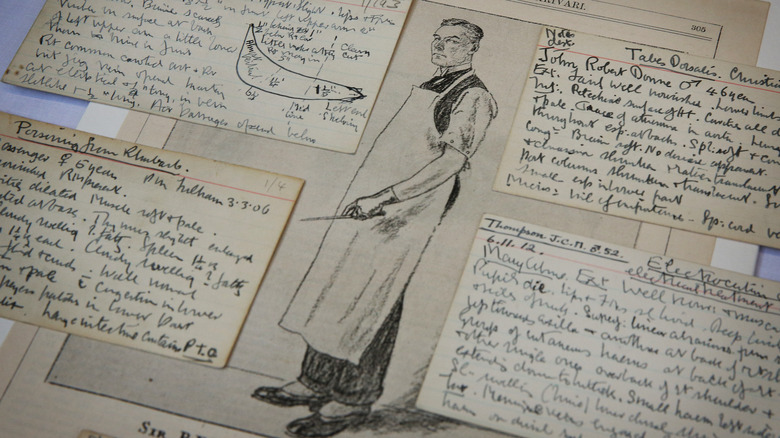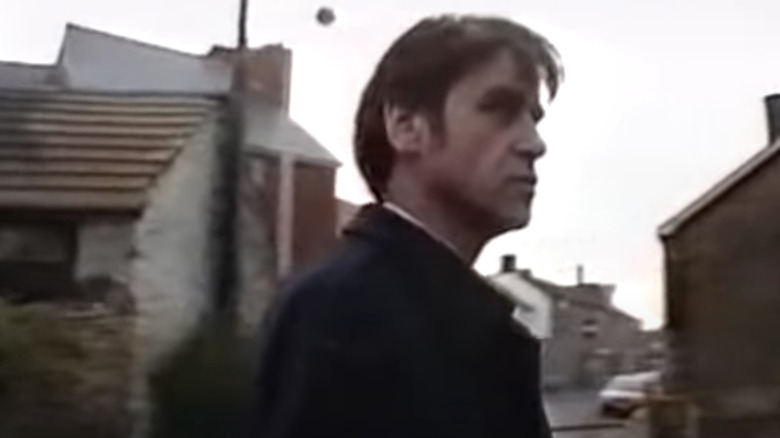The True Story Of The Only Lawyer Ever Executed For Murder In The UK
In 1922, American and British newspapers alike were flooded with headlines about a peculiar murder trial involving poisoned candy, an exhumed corpse, and a garden full of dandelions. Readers were obsessed with each gory detail of the case. A man was hanged for the crime, but many believe that he was innocent. A full century after the case was closed, the true story remains a mystery.
Major Herbert Rowe Armstrong was a respected small-town lawyer in rural England. He was accused of murdering his wife and attempting to poison a business rival with arsenic. As noted by Stephen Bates, the author of "The Poisonous Solicitor," the case has been reexamined by historians – but the most thorough and invested researchers have reached different conclusions. Some are still convinced that the "Hay Poisoner" was a calculating killer who murdered his wife for money, while others believe that Major Armstrong was a grieving widower falsely accused and hanged for a crime that never happened.
Major Armstrong was respected in the community
Herbert Rowe Armstrong came to the rural town of Hay-on-Wye in 1906 to join an existing legal firm. Major Armstrong was a former military man and widely respected in the town. As described in "Exhumation of a Murder," Armstrong was seen as a gentleman. He was well-educated, polite, and decent. As stated in a Channel 4 documentary, he was professionally successful, and after the senior partner in the firm died, the business passed to Major Armstrong. Even though he was a relative newcomer to the town, over the years he had lived in the adjoining village and worked in Hay, he had become a respected member of the community. He kept a vast library at his home, which other solicitors would occasionally use. In addition to his successful legal practice, Major Armstrong was a clerk at the magistrate court in Hay, where he would have provided the magistrate with legal expertise, and he was a churchwarden at the local church, where he likely would have been responsible for church alms and property. He also had the rank of "master" at the Masonic Lodge – the highest rank possible.
The marriage wasn't typical for the era
If there was a flaw in Major Armstrong's near-perfect reputation, it was his relationship with his intelligent wife Katherine. As described in "Exhumation of a Murder," the two were seen as an unusual couple because of their looks. Major Armstrong was 5'6" and reportedly weighed around 100lbs. He was fastidious about his personal appearance, wore enormous high collars, and kept his mustache waxed. Katherine, on the other hand, was described as tall and plain, to the point that some thought they looked funny walking around town together. Worse still, some believed that Katherine was dominating her husband, and made him look ridiculous in front of others by controlling how much he drank and what rooms of the house he should smoke in.
As described in a History Channel documentary, the locals' reactions to the couple may have been a symptom of how women were viewed in this period of history. Women were expected to be deferential to their husbands – which Katherine was not. This does not necessarily mean that Major Armstrong was "henpecked," as some would describe him, but rather that he preferred his wife to be his equal. In many ways, they were a perfect match with many shared interests. They were fond of sharing intelligent conversation and even debating topics as diverse as religion and music – which were very important to them both.
Katherine Armstrong was unwell
While Katherine Armstrong was a strong-willed and intelligent woman, she also struggled with her physical and mental health throughout her life.
As described in a History Channel documentary, Katherine Armstrong had a variety of physical conditions that made life difficult. These included digestive issues, nerve inflammation, and frequently coming down with illnesses. She attempted to combat these illnesses with homeopathic and natural remedies, which she would have delivered to the house. As they can still be today, these remedies were largely untested and sometimes as dangerous as the conditions they were supposed to treat.
Katherine was also plagued by nightmares and feelings of dread and impending doom. She often worried that her husband would die. Over time, these would become more severe, and she would develop what has been described as "paranoid delusions." As her condition worsened, and as described by a Channel 4 documentary, she was certified insane in 1920 by a local doctor named Tom Hincks, and sent to an institution for full-time care for five months. Very shortly after she returned home, she began to ask questions about how lethal certain things were, which made those around her fear for her safety. As described in "Exhumation of a Murder," a full-time nurse was hired to care for Katherine at home. She would die only a month after returning from the institution.
Katherine Armstrong died on February 22nd
In January 1921, Katherine Armstrong told her nurse that she was struggling to hold onto things. When she went outside, she often used a walking stick to support herself. Occasionally, she felt paranoid and believed that there were people in the house in the middle of the night. As stated in "Exhumation of a Murder," Dr. Hincks claimed that there was "really nothing wrong with her" on January 30. On February 8, she celebrated her 48th birthday with her friends and family, and they believed that she was doing much better overall. Just two days later, she was experiencing severe pain, vomiting, and her skin had taken on a strange jaundice-like pallor. The next day, she was unable to walk, and her reflexes weren't responding. She grew sicker and sicker. Dr. Hincks came daily to check on her condition, and Major Armstrong began taking time off of work to sit by her bedside and read to her. She died on February 22. Her doctor stated that he believed the cause of death was gastritis, complicated by kidney inflammation and a heart condition.
Some people thought he didn't grieve his wife enough
After Katherine Armstrong's death, her nurse and a maid closed all of the curtains in the house as a sign of respect for the dead. When Major Armstrong returned home, the first thing that he did was open all the curtains again, letting the sunlight in. As described in "Exhumation of a Murder," there are any number of possible reasons why Major Armstrong preferred to have the curtains open, but later some would question if it was because he wasn't actually grieving.
In the evening, after a quiet funeral primarily attended by close friends and family, Major Armstrong told one of the guests, who was a fellow lawyer, that his wife had created a new will – one which made him the sole inheritor. Some have suggested that Katherine's death benefited Major Armstrong, however, after his wife's death, he never spent any of the money that she had left him. He didn't even transfer it to his account.
As described in a History Channel documentary, men of this era were not encouraged to show emotion – particularly military and legal men like Armstrong. While some viewed his behavior after Katherine's death as cold and unfeeling, his friends and doctor were concerned for him and sent him on a trip a month after her death to try to help him recover.
Major Armstrong had a business rival
When Major Armstrong returned from the trip abroad that his friends had insisted he take, he went back to legal work. A young ambitious solicitor named Oswald Martin had arrived in Hay in his absence. As detailed in a Channel 4 documentary, the two soon found themselves on opposite sides of a contentious land deal.
There was a significant amount of money at stake for both lawyers and their clients. As explained in a History Channel documentary, Major Armstrong was representing a client who was selling their estate. Oswald Martin was representing a potential buyer. There was some dispute about the land titles, which complicated the sale. Martin believed that Major Armstrong was delaying the sale on purpose, for personal gain. The buyer, Martin's client, had already paid a deposit for the land, which was in Major Armstrong's possession (which was customary for the seller's lawyer.) When the sale took too long to go through, the buyer demanded the money back. Martin sent increasingly angry letters to Major Armstrong about the situation. In return, Major Armstrong did something unexpected: he invited Martin to his house to have tea.
His rival accused him of poisoning deserts
Oswald Martin didn't take long to get settled in Hay. Before his dispute with Major Armstrong, he had already been married to a local woman, and his legal practice had become a success. Considering his recent achievements, it probably didn't surprise Martin too much when a box of expensive chocolates was delivered to his home. Strangely, though, the gift was anonymous. As described in a Channel 4 documentary, Martin had a dinner party shortly after and served the chocolates. His sister-in-law ate several of the candies, and, the following day, felt sick. Martin was somewhat suspicious and mentioned it to his new wife's father, Fred Davies, who was the local pharmacist, but neither had any idea who might have sent the chocolates.
In the midst of the dispute about the sale of Major Armstrong's estate, Martin received the invitation from his rival to have tea at his home. As detailed in a documentary from the History Channel, the visit seemed to be a social one, during which Major Armstrong talked about how much he missed his late wife, Katherine. In addition to tea, Martin claimed that Armstrong had given him a buttered scone – which he passed across the table to Martin, apologetically saying "excuse fingers." That evening after dinner, Martin had symptoms similar to stomach flu. Some have argued that it was simply indigestion from the extremely rich meal he had just finished, but Martin's father-in-law found it suspicious.
Major Armstrong purchased arsenic
Fred Davies, Oswald Martin's father-in-law, was suspicious that the two illnesses were more than simple cases of indigestion. He began to believe that Martin had been intentionally poisoned by his business rival Major Armstrong.
Davies ran the local pharmacy, and recalled that Major Armstrong had purchased arsenic. As noted by a documentary from Channel 4, this was not actually unusual in 1921. Arsenic was used to make a popular weed-killer, and Major Armstrong's garden was full of dandelions. Major Armstrong was seen in the garden attempting to kill the weeds with an arsenic solution (though he appeared to have been unsuccessful in getting rid of the dandelions.)
Despite arsenic being legal and commonly used, Davies found its purchase from his shop suspicious – partly because of the apparently sudden death of Katherine Armstrong. As described in a History Channel documentary, he and Dr. Hincks decided to have Martin's urine and the remaining chocolates tested for signs of arsenic poisoning. Unfortunately, the doctor also gave Martin bismuth for his stomach, which sometimes was contaminated with arsenic.
The results, reprinted in "Exhumation of a Murder," showed that there was arsenic in both the urine and the chocolates. On New Year's Eve, the police arrived at Major Armstrong's office. They questioned him for over six hours and finally searched him. At the time, he was wearing his gardening jacket, and they found some of the arsenic he had purchased from Davies. He was arrested.
They exhumed his wife's body
While Major Armstrong was in a jail cell, the investigation continued. The police decided that the only way to find out the truth was to exhume the corpse of Armstrong's wife Katherine, who had been buried 10 months before.
While the local police did everything they could to keep the public from entering the graveyard, rumors circulated widely, and by the time the grave was dug up and the coffin removed, there was no hiding what was going on. As described in "Exhumation of a Murder," it was noted that the coffin itself looked perfectly preserved as if it had just gone into the ground. The body did not. One of the many onlookers from Hay was a 17-year-old boy who managed to catch a glimpse of the body. He claimed to have been so terrified he barely slept for two weeks.
Dr. Hincks, another local doctor, the undertaker Humphrey Vines Webb, and the most well-known pathologist in the country, Dr. Spilsbury, met to perform a post-mortem. As stated in a documentary from the History Channel, arsenic was found in the body of Katherine Armstrong. Dr. Spilsbury believed that she had taken the fatal dose within 24 hours of her death.
The judge was known as a hanging judge
The strange case was a sensation. Crowds waited outside the courthouse every day, and reporters and photographers vied to get key details and photographs for their readers. As described by her niece in a documentary from Channel 4, Major Armstrong's maid accompanied him into the courthouse, hiding his face from the photographers with her shawl.
The judge for the trial was Justice Charles Darling. As described in "Exhumation of a Murder," Darling was 73 years old and had presided over contentious cases in the past. He also had a reputation as a "hanging judge" and was generally considered more likely to select a harsh sentence. Dr. Spilsbury appeared in court to give his report, testifying that Katherine Armstrong had died from arsenic poisoning at some point in the final day of her life (which, as noted by a documentary from the History Channel, with the benefit of a century more forensic knowledge, was likely incorrect.) The judge, Justice Darling, seemed thoroughly convinced by the prosecution throughout the trial and encouraged the jury to agree. Strangely, Darling seemed to interrogate Armstrong himself, asking more than 100 questions throughout the trial, as he was a part of the prosecution. The defense argued that Katherine Armstrong might have taken the arsenic herself – but Justice Darling publicly dismissed the possibility. Before the jury deliberated, Darling summed up the case for them, concluding that Major Armstrong was the killer. The jury agreed he was guilty of murdering his wife.
Armstrong was hanged
Justice Darling sentenced Major Armstrong to death by hanging. As described in "Exhumation of a Murder," Armstrong remained stoic throughout the sentencing, but it was rumored that he collapsed in his cell. Onlookers and photographers clamored to see the condemned man as he was taken back to the prison where he would await his death.
Those who saw Major Armstrong that night remarked on how incredibly calm he seemed. He wrote notes and sent gifts to the men on his defense team. In the morning, he changed out of the prison uniform and into his suit. He asked if they had his collar, presumably in the uniquely large style which he was known to like, but was understanding when it couldn't be located. He thanked the two prison officials who had been assigned to watch him, and before he was taken out of the cell, he gave them his pipe and glasses.
Thousands of curious onlookers crowded around the prison gates, trying to see the execution. Some even watched from the rooftops of neighboring buildings. Major Herbert Rowe Armstrong was hanged at precisely 8 a.m. on the morning of May 31, 1922. He remains the only lawyer in the history of the United Kingdom to be hanged for murder.
The Hay Poisoner legacy was challenged 70 years later
In 1995, a lawyer named Martin Beales published a book called "Dead Not Buried" arguing that Major Armstrong had been falsely accused and wrongly convicted. As described by The Guardian, Beales, like Armstrong decades before him, moved to Hay-on-Wye to work at the local law firm. Beales worked from Armstrong's old desk. Incredibly, Beales and his family also moved into the house where Major Armstrong and his wife Katherine had lived. Unsurprisingly, Beales became fascinated by the case, and the more he researched, the more convinced he became that Major Armstrong had been innocent. He met with the Armstrongs' daughter Margaret, who is a firm believer in her father's innocence.
A century after Major Armstrong's death, many agree with Beales that Armstrong did not receive a fair trial. However, the question remains: If Major Armstrong did not kill Katherine, who did? Some believe the answer is "no one."
As stated in a documentary from the History Channel, with greater knowledge of forensic science, it is now believed that Dr. Spilsbury was mistaken about the timeline of Katherine's death. It is possible that Katherine Armstrong took smaller doses of arsenic over time, rather than having been given a single fatal dose the day of her death. Due to her many health conditions, Katherine took many medications daily, some of which were prescribed by her doctors and some of which were home remedies. Like Oswald Martin, Katherine was taking bismuth, which frequently contained arsenic.
